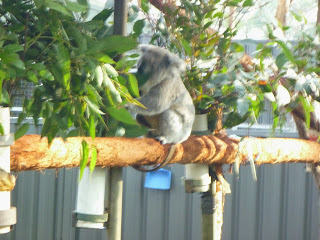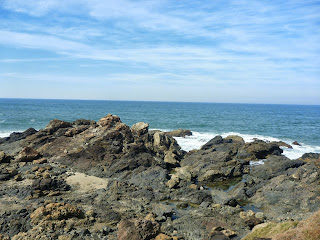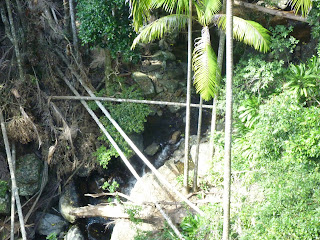One of the popular activities is to have fish and chips on the foreshore and there are a number of specialty fish and chip shops catering for this. Of course, mention fish and chips and we couldn't leave them out of our weekly menu! So with the temperature at 28 degrees, and with Penny the dog accompanying us, we drove down to the town centre, parked and headed for one of those popular fish and chip shops. Were they great? Well, the chips were lovely but I didn't like the fish variety but I guess that all comes down to personal choice. Penny was happy to eat my share and Peter said the fish was okay but not his first choice either. Sounds as though we wouldn't be repeating this outing.
There were a number of pelicans wandering around the grass area - I didn't realise that pelicans were scavengers but these ones certainly were. In fact a couple were close to eating out of the hands of one couple who were feeding them chips.
There is a statue on the waterfront - it is a life size bronze sculpture of Australia's first Prime Minister, Sir Edmund Barton. It is a very popular place for taking photographs so we may as well do the same. After offering to take a photo for two ladies they did the same for us.
From here we began the coastal walk - this walk begins on Town Green foreshore and continues all the way to Lighthouse Beach and is nine kilometres long. We completed the walk over a few days. The Town Beach section follows the foreshore pathway out to the rocky breakwall. Although it was about 28 degrees it was really windy and this spoilt the walk a bit. On one side of the pathway we had the entrance to the Hastings River and on the other side a caravan park - no wonder there were so many grey nomads in town.
Penny just loved walking into the wind - she certainly enjoyed it more than us!
Along the walkway the rocks are very brightly painted. Apparently it is a tradition for locals and visitors to seek out "rock" which becomes their personal canvas of memories of past holidays or a tribute to a loved one. It is now hard to find a rock that has not been painted. This is a real change from seeing unsightly graffiti and commenced with an art competition in 1995. It certainly made the walk interesting.
We walked as far as Town Beach - a very popular swimming beach and then made our way back through the caravan park (just because we could and it wasn't anywhere near as windy down off the breakwall) and eventually back to the car. Our exercise complete for the day and perhaps we had walked off the effects of the fish and chips.
 |
| Town beach |

























































